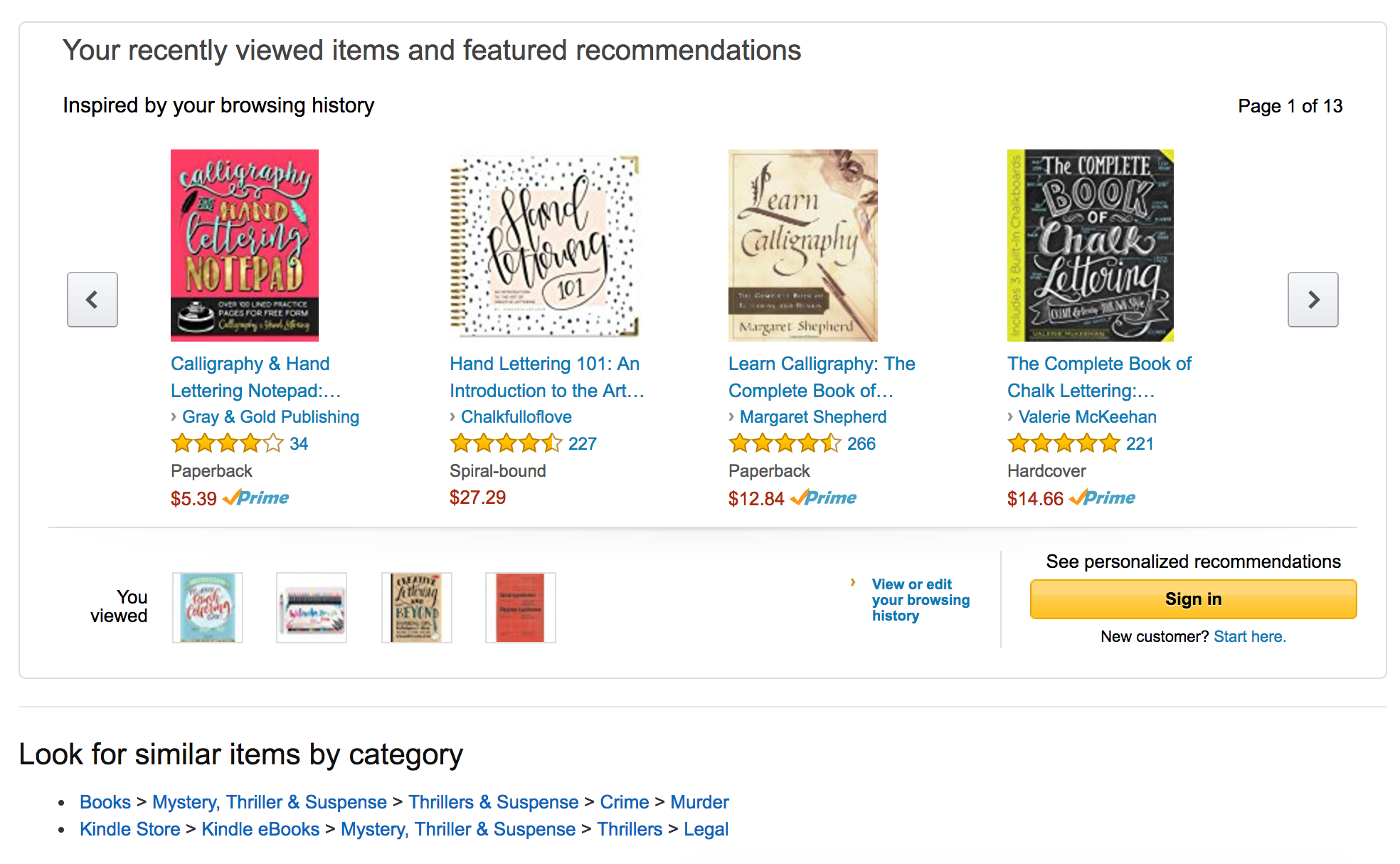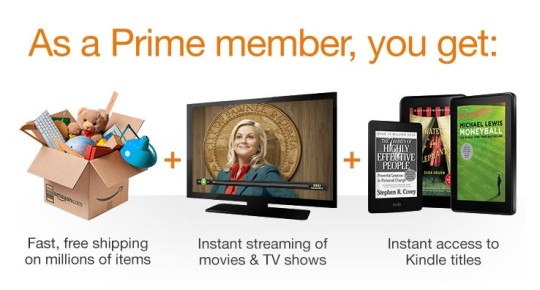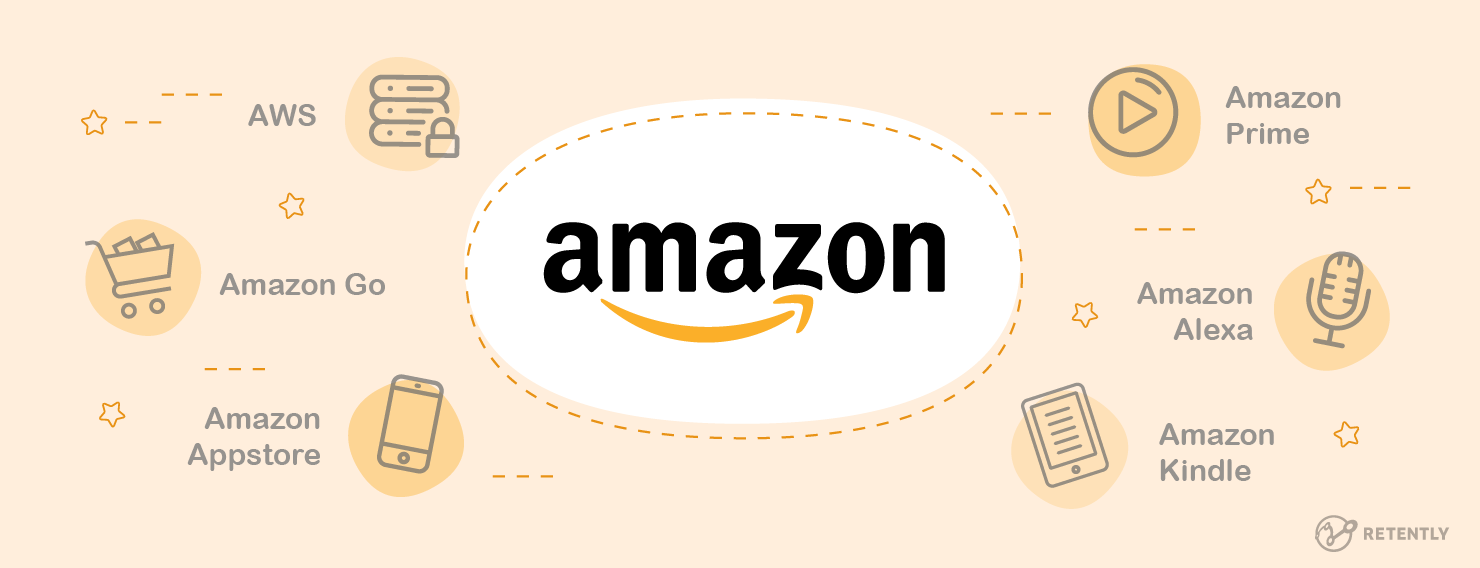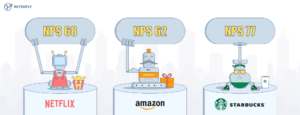Table of Contents
From its humble beginnings as an online bookseller, Amazon has grown to become one of the world’s largest ecommerce businesses. But unlike many massive multi-national organizations, Amazon remains incredibly popular with its customers.
In fact, so popular that:
- Amazon is ranked #2 in the Top 100 Retailers 2023 List with $343.33 billion in worldwide retail sales.
- It is expected to capture over 40% of the U.S. ecommerce market, reinforcing its top position.
- Amazon maintains an NPS 60% higher than traditional retailers like Macy’s and was ranked the most trusted US brand in 2022.
- Customers complete 28% of Amazon purchases in 3 minutes or less and 50% of purchases in less than 15 minutes.
- Amazon ships to customers in over 100 countries and regions.
- According to Prosper Insights’ survey, Amazon attracts about 80% of Macy’s frequent shoppers during the holiday season.
Amazon has redefined the meaning of the shopping experience. Now shoppers don’t need face-to-face communication to make a purchase and gain public trust. Good pricing, product reviews, fast shipping, and easy returns seem to have replaced traditional shopping.
Let’s explore specific use cases and uncover practical approaches to an impressive NPS, following Amazon’s example.
Key Takeaways
- Amazon’s ongoing investment in technology and its willingness to learn from failure have driven successful innovations like Amazon Locker, Echo, and FireTV.
- By leveraging customer data, Amazon tailors shopping experiences with personalized recommendations and marketing.
- Amazon Prime’s comprehensive benefits, including free delivery and exclusive content, strengthen customer loyalty and increase spending.
- User-friendly self-service tools allow customers to resolve issues on their own, saving time and making the experience smoother.
The Secrets of Amazon’s Success
Amazon’s journey to success has been long and challenging. For years the company posted little or no profit while refining the technology and processes that power its current success.
The good news? Your business can “borrow” many of these techniques to boost your customer satisfaction ratings. Here are some to consider.
1. Investment and Experimentation
Amazon has never been shy about spending money. The business invests vast sums in ensuring that its back-end processes are as efficient as possible. It also spends a lot on research and development, building new products and services it believes will be of value to customers.
This willingness to experiment is combined with a willingness to fail, too. While no one likes failing, it comes with the territory. The Amazon Fire Phone released years back was not a hit with customers, reporting a $170 million loss.
Yet, Jeff Bezos, then CEO of Amazon, explained that “as a company grows, everything needs to scale, including the size of your failed experiments. If the size of your failures isn’t growing, you’re not going to be inventing at a size that can actually move the needle…The good news for shareowners is that a single big winning bet can more than cover the cost of many losers.”
While the phone was unsuccessful, they learned valuable lessons that have served them well when working on devices like Echo and FireTV.
On the other hand, Amazon Locker, which allows customers to collect packages from secure locations because they cannot take delivery during office hours, has been an unqualified success, also enhancing Amazon’s NPS.
Amazon does have the luxury of very patient shareholders and investors, allowing them to spend much more than their competitors. For smaller companies, funding needs to be controlled more tightly – but that does not mean sacrificing the capacity for experimentation, especially if the customer experience is compromised as a result.
How to Implement Following Amazon’s Lead
- Prioritize Key Investments: Focus your spending on areas that enhance customer satisfaction and boost operational efficiency. Even with limited resources, strategic investments can deliver substantial returns.
- Encourage Experimentation: Create an environment that encourages innovation, allowing your team the freedom to explore new ideas through trial and error. Create a safe space where employees can propose and test innovations without fearing failure.
- Learn from Failures: Treat every failure as a valuable learning opportunity. Analyze missteps to refine and improve future projects.
- Balance Risk and Reward: Take strategic risks by ensuring each experiment has the potential for significant rewards, despite the possibility of failure. Allocate resources wisely to support both ongoing operations and new ventures.
- Leverage Customer Feedback: Use customer feedback to guide your innovation efforts. Understanding customer needs and challenges can help develop solutions that are more likely to resonate and succeed.
2. Personalization Everywhere
By carefully monitoring how customer interactions unfold on its website, Amazon builds a very detailed, highly accurate picture of its individual customers. This information then forms the basis of every email and marketing effort.
Shoppers using the Amazon website will see a list of recommended products at the bottom of every page, including items they have previously browsed but not purchased. This is followed by regular emails encouraging shoppers to return and make more purchases.

New products like Alexa and Echo will only help to enhance this profile creation further. By listening to their owners, these devices feed real-time information back to Amazon allowing them to add extra context to profiles that cannot be collected by website usage monitoring alone.
Also, if you have registered a complaint with Amazon, you don’t have to tell the same story next time you reach out to them. The records of customer complaints are persistently stored in Amazon’s centralized database, and can be accessed conveniently by any customer service executive.
Building on its legacy of innovation, Amazon announced updates to its artificial intelligence capabilities on July 10, 2024, reinforcing its leadership in the competitive AI market where investor interest remains high. The updates include smarter AI agents that can remember whether a user prefers aisle or window seats during flights – a new feature reflecting Amazon’s commitment to personalization.
Moreover, the company has refined its Q chatbot, introduced last November, to provide more advanced code-writing suggestions, addressing the growing demand for generative AI tools. These improvements, driven by machine learning, aim to sharpen customer behavior analytics, ultimately boosting NPS scores by delivering even more tailored experiences.
How to Implement Following Amazon’s Lead
- Analyze Customer Data: Start by gathering and analyzing data on how customers interact with your website or services. This information can be used to build detailed customer profiles, offering insights into their preferences and behaviors.
- Personalize Recommendations: Deploy advanced systems designed to suggest products or services that align with past customer behaviors. Feature these personalized recommendations on your website and within follow-up email campaigns to increase visibility and engagement.
- Centralize Customer Records: Maintain a centralized database to log all customer interactions, including any complaints. This repository should be easily accessible to customer service representatives, enabling them to offer seamless support based on comprehensive historical data.
- Engage Regularly: Keep the conversation going with customers through personalized follow-up emails. Remind them of previously viewed products and introduce new items that match their interests.
- Pursue Continuous Improvement: Always iterate – regularly update your personalization algorithms and engagement strategies based on fresh customer data and feedback. This commitment keeps the customer experience relevant and engaging.
3. Subscription Membership
One of Amazon’s most successful strategies has been its Prime subscription. Amazon Prime has grown from a priority delivery service to a value-add membership program designed to enhance customer loyalty.
Not only do members receive their goods quicker (and for free). They now have access to Amazon Prime TV entertainment content and even priority booking for tickets to shows and concerts.
Jeff Bezos told investors that the idea behind Prime is to make “such a good value, you’d be irresponsible not to be a member.” This reflects the core of Amazon’s NPS strategy, which aims to deepen customer relationships.
Although the company has added more and more new perks to its Prime subscription, 63% of Amazon shoppers report that free delivery is the most important factor in their purchasing decisions.

So, while Prime subscribers pay for the privilege, they also receive unlimited free postage. The deal works out well for Amazon, too. Prime subscribers typically spend 300% more than non-subscribers.
How to Implement Following Amazon’s Lead
- Identify Key Benefits: First, pinpoint what your customers truly value. Whether it’s faster delivery, exclusive content, or special access, you need to understand these preferences. Build your customer loyalty program around these benefits to ensure it resonates with your target audience.
- Create Tiered Membership Levels: Develop various membership levels, each offering specific perks. This strategy caters to different customer needs and budgets, encouraging members to upgrade as they seek more benefits.
- Bundle Services and Products: This could include anything from exclusive content and special event access to members-only discounts. Bundles add value to the subscription and provide valuable insights.
- Communicate Value Clearly: In all marketing communications, emphasize the most valued features of your membership program, such as free delivery, to attract potential subscribers and positively impact your Net Promoter Score.
- Encourage Upgrades and Renewals: Use personalized marketing strategies and special offers to motivate current members to renew or upgrade their subscriptions. Continually introduce new perks to maintain interest. Constantly monitor the membership program’s performance and ask for customer feedback.
4. Effective Self-Service
Although they appreciate traditional service channels (phone, email, regular mail, etc.), most actually prefer to use self-service tools – at least in the first instance. Amazon has carefully refined its service processes, making many key operations available to customers.
Instead of calling a customer service rep to report a problem, shoppers can log a call in their account control panel, and carry out much of the initial escalation themselves.
This level of control allows them to “own” their issues and frees up Amazon’s internal resources to focus on delivering excellent service on aspects that cannot be solved without human intervention.
Shoppers expect businesses to respect their time and trade with them as easy as possible. In fact, Forrester Research found that 73% of customers believe that “valuing their time” is the most important thing their suppliers can do for them. And by providing the tools needed to initiate problem-solving, Amazon is clearly demonstrating respect for its customers.
How to Implement Following Amazon’s Lead
- Develop User-Friendly Self-Service Tools: Build intuitive online tools that allow customers to address issues independently. These tools should be straightforward to navigate and enhance the user experience.
- Provide a Centralized Dashboard: Implement a user-friendly dashboard where customers can easily manage their accounts, log issues, and monitor the resolution process. This reduces the need for direct contact with support teams, streamlining customer interactions and likely boosting Net Promoter Scores.
- Automate Common Issues: Pinpoint the most frequent issues faced by customers and automate their resolutions. This could include deploying automated troubleshooting guides, FAQs, and chatbot support.
- Maintain Human Support for Complex Issues: While automation handles routine inquiries, complex problems should still be directed to human customer service representatives. Ensure these issues are easily escalated and provide customers with clear guidelines on how to seek further assistance. The goal is to minimize the time customers spend resolving their issues, which greatly improves their satisfaction.
5. Diversified Product Base
As mentioned earlier, Amazon began as an online bookseller – but as new opportunities have presented themselves, product lines have expanded. In addition to physical goods, Amazon customers can now purchase digital downloads, groceries, and hardware – like Kindle e-readers and the Alexa digital home assistant.
Amazon has also found a way to productize its own internal processes. The Amazon Web Services (AWS) cloud service replicates its internal infrastructure, making the same flexible computing model available to other businesses. By selling a subscription to these computing services, Amazon is also a significant player in the infrastructure services market.
While the COVID-19 pandemic pushed consumers toward remote care and online shopping, Amazon seized the opportunity to lay the ground for wider healthcare services with Amazon Pharmacy. Launched in November 2020, it was described by many as Amazon’s most significant venture into the healthcare industry. In 2021, Amazon’s medication delivery service became the leader in the Drug Stores & Pharmacies industry with an NPS score of 66.
By constantly expanding its offering, Amazon has become a one-stop shop for a huge range of goods and services. This makes shopping with Amazon particularly convenient, boosting NPS and ensuring repeat purchases.
How to Implement Following Amazon’s Lead
- Diversify Product Offerings: Scout for opportunities to broaden your product range. Think about what complementary products or services your customers might need that could enhance their overall experience with your brand.
- Capitalize on Internal Capabilities: Evaluate your existing operations to identify unique processes or tools developed internally that could be transformed into marketable products. For instance, a proprietary software initially designed for internal use could be offered as a standalone product to the public.
- Stay Agile with Market Dynamics: Monitor consumer behavior shifts and emerging market trends closely. Be prepared to adapt quickly and capture new opportunities, such as Amazon’s foray into healthcare services during the pandemic.
- Enhance the Customer Journey: As you expand your product lines, ensure they are woven into a user-friendly shopping experience. Streamline navigation, provide detailed product descriptions, and ensure support is readily accessible. Monitor NPS performance and make necessary adjustments to enhance retention.
6. Customer-Centricity
“The beauty of this mission is that you never run out of runway; customers always want better, and our job is both to listen to their feedback and to imagine what else is possible and invent on their behalf.” – Jeff Bezos
Reading through the many press-releases and statements over the years, Amazon has always placed the customer at the core of what they do. The brand works backward from the customer, not the other way around.
The new product ideas pursue something that meaningfully changes customer experience over a long period of time – with “long period” being a keyword here. That’s because the company focuses on better long-term experiences and loyalty rather than short-term success, no matter the investment.
They put themselves in the customer’s shoes and are always all ears for customer feedback. The brand is willing to learn what users want or dissect what doesn’t work well for them to create better solutions. With that in mind, they make good use of customer satisfaction surveys – at critical touch points – and regular follow-ups. Turning to feedback loops and analyzing data is vital for managing customer expectations.
Moreover, Amazon offers the opportunity to rate received products/sellers and submit reviews, thus building trust and handing more control over the shopping experience to the customer.
How to Implement Following Amazon’s Lead
- Engage Actively with Customers: Employ different channels to capture customer feedback, including surveys, social media platforms, and direct customer interactions. Train your team to respond effectively, ensuring that customers feel heard and valued.
- Forge Long-Term Customer Relationships: Focus on developing products and services that offer lasting benefits to customers rather than pursuing short-term gains.
- Leverage Data for Strategic Insight: Use advanced tools to gather and analyze data from customer feedback and behaviors. Apply these insights to refine your product offerings and enhance service strategies.
- Establish Effective Feedback Mechanisms: Provide customers with the means to influence their experiences directly. Simplify the feedback submission process, making it straightforward for customers to share their suggestions with your brand.
- Customize Customer Interactions: Based on the insights gained, tailor interactions and promotions to meet each customer’s unique needs and preferences. Customize your communication and services to reflect individual customers’ histories and preferences.
- Maintain Ongoing Communication: Regularly follow up with customers to assess their satisfaction and resolve any issues. This consistent engagement shows customers that their feedback is important and that your brand is dedicated to continuous improvement.
Complex, yet Simple
Many of Amazon’s internal techniques are quite complex (the Amazon AWS Cloud arm of the business is incredibly technical). Still, they are all focused on the same goal – happy customers. Every development, innovation, and new service is designed to make customers’ lives easier.
From more accurate product recommendations to applying technology to simplify the shopping process, everything Amazon does is focused on making things easier and more convenient for their customers.
If your business cannot replicate anything else that Amazon does, it can still borrow this relentless focus on customer satisfaction. After all, a customer-focus ethos is free to adopt. And ultimately, it is only by providing an outstanding customer experience that you can push your NPS scores upwards.
For more help and advice about measuring NPS and using it as a metric for your own business performance, please get in touch with Retently to arrange a demo.



































 Alex Bitca
Alex Bitca 

 Greg Raileanu
Greg Raileanu 

 Christina Sol
Christina Sol 
